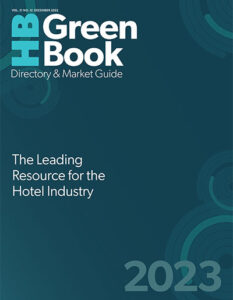As 2022 comes to a close and the hotel industry moves on to 2023, there are many positive feelings toward the recovery from the pandemic. However, there will still be some lingering challenges—inflation, supply chain issues, the labor crisis—that will carry over into the new year.
Moderated by Glenn Haussman, founder/host, No Vacancy Live podcast, the recent Hotel Business Hot Topics session, “The Time is Now: Prepare your business for 2023,” in partnership with Entegra, offered a discussion on what the year ahead may look like from a trends perspective, and provided a forum for a panel of industry leaders to provide advice to navigate what lies before them.
The panel included Damien Calderini, president/CEO, Entegra; JP Ford, SVP/director, global business development, Lodging Econometrics; Denis Klurfeld, VP, procurement, North & Central America, Accor; Vineet Nayyar, president/COO, owned division, GF Hotels & Resorts; and Rob Smith, divisional president, full-service, Aimbridge Hospitality.
Hausmann first asked the panelists what they thought will be the biggest issue in 2023. Before providing his answer to that question, Calderini brought up the topic that is likely on every hotelier’s mind at the moment—inflation.
“No one can predict the future, but we really believe that inflation is here to stay,” he said. “Inflation is global and it’s driven by factors that will not go away overnight. People were wondering whether the election might have an impact on it one way or the other. I will tell you that we don’t believe that will be the case.”
He added that the causes of inflation are “the war in Ukraine, which everybody understands the impacts that it has on the grains that are not being transported; labor issues, whether it’s just simply not finding truck drivers to be able to move the goods, or it is back or front of the house [on the property level].”
However, inflation is not the most concerning issue in Calderini’s eyes; instead, it’s the weather and avian flu.
“The biggest impact to the supply chain challenges and the food challenges we’re seeing today is the weather,” he noted. “Quite frankly, we should all look at how the weather is going to be in early 2023 and hope that we get the weather that we need because that is going to be the main driver. The second one is avian flu. Every year you see avian flu spiking once, but what are we seeing this year? It’s coming, it’s going, but it’s coming back and it keeps coming back. That’s going to have a significant damage.”
Nayyar believes the biggest thing the industry is dealing with is the uncertainty of what will happen in the future. It’s certainly something that’s hasn’t left since the pandemic began.
He offered a way to deal with the uncertainty. “We can control ourselves by being proactive [and]efficient,” he said. “Two years ago, we were talking about isolation; now we’re talking about inflation. Margins are going to be tough… You’re paying more and you’re getting less.”
Smith pointed out that there is so much uncertainty going forward that you can’t plan for just one outcome.
“All these factors that have been noted are all variables,” he said. “They’re all things that are sitting out there that have the potential to take what we see today and wreak havoc tomorrow. A lot of things that we’re doing now as we build budgets, we’re building them for the things that we know we can affect—the things we see today. And we’re building four or five contingency plans behind those so that as things do change, we’re able to react quickly and nimbly.”
Hoteliers will also have to deal with travelers whose priorities have changed as to what they expect from a hotel stay. Haussman asked Klurfeld if he is seeing the products that are going into the properties reflecting the demands of today’s guests.
“We had to rethink everything from the ground up in terms of what people care about, what they expect and what they no longer want,” said Klurfeld. “And that really focuses the procurement on what really drives value. All of the non value-added products and services, you either eliminate, automate or outsource. So, we’ve essentially been really focusing the procurement efforts on identifying what really is going to drive value in the next two to three years, and really focusing on those aspects of the guest experience.”
Going back to the issue of inflation, the moderator asked Ford, who’s company monitors hotel construction in the U.S. and internationally, how the increase in interest rates is affecting the pipeline.
“It’s really causing developers to pause, sit back [and have a]wait-and-see attitude,” said Ford. “There are about 985 hotels under construction in the United States right now. Prior to COVID, we’re well into a thousand under construction. We have [more than]4,000 hotels that are either going to start in the next 12 months or are in the early planning [stage]. Supply chain issues are also a problem. You can’t find the products that you need as fast as you need them. So, with interest rate increases and supply chain issues, the movement of projects through the pipeline isn’t going as fast as what it did pre-COVID.”
Flurry of renovations
The U.S. renovation and conversion pipeline right now, he pointed out, is as high as it’s been in as long as Lodging Econometrics has been monitoring it, with about 1,900 projects and 240,000 rooms
“And I’m not talking about small renovations,” said Ford. “I’m talking solid, seven-figure renovations. What I always say when people come to me and [ask], ‘What should we do?’ I say, ‘If you are a supplier in the hotel business and you’re looking to find an owner that will be open to talking to you about your products and possibly making a change, the best time to do that is when [the owner]is going through or planning a renovation or converting from one brand to another, brand to an independent or independent to a brand because that’s when an owner is most open to talking about changing what’s currently on the site right now.”
Nayyar noted that owners are trying to get these renovations done because their loans have “a great interest rate currently that are three to five years out.”
He added, “There’s [also]the pressure from the brands. They’ve been sitting and giving waivers for the last two to three years, and those milestones are about to expire. To be competitive, you have to do it.”
Wellness trend
Wellness travel is one of the trends that gained traction coming out of the pandemic and will likely continue to be a focus of hotels in the new year. Haussman asked Klurfeld about the ways Accor is adding wellness features at its properties.
“There’s been a lot of conversations within our guest experience team as far as what we define wellness as moving forward,” the Accor executive said. “I think, at the end of the day, it’s trending towards meeting the customer where they want to essentially be from the custom solution that they’re expecting. So, it’s whether or not we are partnering with yoga instructors, offering bespoke spa services depending on customer preferences before they arrive or at at-request training sessions within the gyms and really reinventing what the gym looks like. But, it’s really around understanding what the customer needs are and making sure that we are staying ahead of the curve. There isn’t a single solution to address that.”
For Aimbridge’s full-service portfolio, Smith noted, wellness programs “are really table stakes in our resort operations these days,” adding, “Folks during the COVID period went through a period where they stayed at home and gained weight, and then went through a huge wellness program on their own at home. Now, when they travel, they want to enjoy and do all the best things they can, but they also want to make sure they don’t fall off those programs. So, we make sure, as part of our resort fees, that we include things like sunrise Tai chi, pool aerobics and things that they won’t typically do as a form of wellness at home so that it’s new things they’re learning. It’s not only wellness but it’s enrichment, and it just helps the overall satisfaction of the guest’s stay.”
Ford has also seen wellness experiences being added during the renovation process with the hotels in the construction pipeline.
“They’re renovating hotels with those concepts in mind and allocating the appropriate spaces through renovation to allow a lot of that wellness activity to take place,” he said. “The other thing that we’ve seen, too, is there’s been a plethora of new brands that have been announced into the industry over the past five years—some are new-construction and some are conversion brands—but the industry has really segmented itself into collection and lifestyle brands, which are somewhat synonymous with wellness.”
Nayyar also noted that “we cannot go past the cleanliness component [as the]starting point of wellness. What we learned in that last two-and-a-half years is we cannot go out of the box unless the hotels were clean. That’s the No. 1 thing that we cannot forget with all the stuff that has happened.”
Healthy F&B
The food that is served at a hotel’s food and beverage outlets can certainly fall under a wellness discussion, as Calderini brought up.
“I think it’s relevant because it addresses wellness, and it can also help on the cost side,” he said of offering more plant-based items to menus. “Putting more vegetables on the plate and reducing a little bit of the meat portions [can do]a lot for the wellness of people and do a lot to improve the costs.”
He continued, “A lot of thought goes into how to prepare the meats. There’s so many ways—smoking, broiling, grilling, roasting, etc. You can do the same thing with vegetables and get an amazing outcome. You’re doing a good service for your clients, and you’re doing a good service to your P&L.”
Haussman added to the healthy food talk, commenting, “I do think vegetarianism and veganism are really starting to hit the mainstream in a meaningful way. That means hotels are going to have to get out from just having salads and a side of broccoli into creating [items]that make vegetarian food awesome.”
Meat eaters don’t be alarmed. When asked if he has seen a movement away from meat offerings on hotel menus, Klurfield said, “I don’t think it’s moving away from meat. You still have to make sure you provide the same amount of selection and experience for the meat-eaters.”
However, “you do need to find opportunities to really elevate the vegetarian side of things and make sure that you reflect that in your menus,” he explained, turning to the subject of alcohol. “You also see a big shift in this idea that people no longer want to consume alcohol, but they still want to have that cocktail culture. So, there’s amazing companies out there that essentially are creating not fake mocktails, but cocktails that have no alcohol content but taste exactly like a Negroni or an Aperol Spritz. You need to essentially provide both options in order to create that destination experience and be that location of choice for these groups.”
Sustainability has become a major focus of hotel companies in recent years. Many of them have published their own Environmental, Social and Governance (ESG) reports, and associations like the American Hotel & Lodging Association (AHLA), AAHOA and the Sustainable Hospitality Alliance have launched programs and initiatives to help hoteliers do their part in saving the planet.
Calderini, as a procurement specialist, has seen first-hand how hoteliers are purchasing eco-friendly products in an effort to “go green.”
“I don’t think that sustainability is a trend—it’s a thing,” he said. “Sustainability is here to stay. There’s no way that it’s going away. And every large or medium company has a CSR [or ESG]plan or should have a plan on how they’re going to embrace sustainability.”
Food options can also be sustainable offerings, as noted by Klurfeld. “Our chefs are incredibly passionate about creating sustainable options for our guests,” he said. “We have beehives in our hotels that essentially are there to make sure that we can pollinate the crops. And we also [harvest]honey. Every single resort that we operate has a garden where it grows its own produce. There are efforts to source a certain amount of products within a particular radius to make sure that we can provide that local experience.”
He believes that “If the hospitality industry doesn’t adopt [sustainabile practices]at some point, that will be the death knell in our existence. Hotels that don’t care about carbon, don’t care about single-use plastics and do not care about the impact that they have on the environment will not be chosen as the destinations of the future. It’s the investment that you make today that’s going to really dictate your existence tomorrow.”
Supplier diversity also falls under the ESG umbrella, and Klurfeld added, “As much as we care about the local small producers, we also must provide opportunity to groups that have been historically disadvantaged to make sure they have a fair chance.”
Smith pointed out that “sustainability over the lifetime of my career has changed from really a PR catch-word to a necessity,” adding, “I think as we see inflation and rising costs, people who didn’t pay attention to sustainability in the past are now seeing that sustainability is also part of the evolution of our margin. And, if you don’t have sustainability within the various groups around you, you’re not going to have competitiveness.”
Expanding on Klurfeld’s point about supplier diversity, Smith said, “One of the problems that I saw early on in group purchasing was that we often went to the big companies to buy things, and the smaller companies started to get squeezed out. We make sure that we have a very easy process through our market basket so that we buy as much as we can within the local community, and we make it as easy as possible. The vendor themselves goes in and signs into our program and becomes a part of it so that our folks on the property can continue within our volume buying, but [also]to include those local vendors.”
As the CEO of a group purchasing organization, Calderini took the time to point out that his company not only works on the national level, but the local level as well.
“When people think about GPOs, they think about scale, but they think about scale at a national level,” he said. “We don’t think about scale that way. Of course, we have that too because of the $46 billion [worth of buying power], and we work with about 1,800 national vendors. But we also work with about 4,000 or 5,000 local vendors because we also think about local scale. The good news is if you have a property in one area, the odds are Entegra has a dozen more hotel clients, plus schools, plus restaurants, plus senior homes [in that area].”
Technological innovations
Technology is certain to play a big role in the industry as hotel companies must keep track of the latest innovations that not only enable property to run more efficiently, but also fulfill guests’ needs. A member of the audience asked panelists what the most impactful technology solution they’ve seen implemented in the industry, as well as what they are excited about moving forward.
Nayyar pointed to mobile check-in as an innovation that has changed the industry. “We want to check in as soon as we land at the airport,” he noted. “We want to go right past the desk. That’s what technology has done for us. I think all the major brands are putting a lot of resources behind it finally. What COVID has taught us is to just be efficient.”
Smith took a different slant, looking at technology from an operations perspective. “I went to a Marriott Advisory Board meeting that was about rooms, and I saw something that I think is going to really change the way we do business. They are in the process of testing a bed that is raised up into the ceiling, and it uses RV technology, so that you can turn a room from a double-double to a king. And when the bed rises, out comes either a desk or a kitchen table. I was amazed by it. It was incredible, and I think it really is going to change how we use space in the hotel industry. They were saying that they’re going to be able to put 30% more rooms into a building based on this technology.”
He continued, “I think simple things like not having to cable a building for television. If you go behind the walls of some of these buildings, and you see the past cables, it’s just something we don’t think about, but is incredibly expensive for an owner to recable the building. I think things like that are going to make our lives [easier]. We’re going to be able to adapt to new standards quicker when we can get a hold of technology like that.”
Developers are always looking for new, creative, innovative ways to attract guests, according to Ford, who added, “I’m all for new technology in hotels. I’ll admit I’m a little bit old school, but I think we have some great technologies right now. I’m a little bit unfamiliar with all of the operational technologies that happen behind the scenes, but one of the things I saw recently was an alarm clock that charged my phone, and it shot the time right up into the ceiling along with the outside temperature.”
Calderini said he is surprised that most of the industry has yet to adopt robotics to complete menial tasks around hotels.
“We’ve put robots on college campuses delivering food,” he said. “You think about large resorts where you’ve got to have someone run around just deliver the food. Robots can do it. There’s a very cool factor. If the 20-something-year-olds love it, the clients are going to love it. And I’m just eager to find a client that will want to work with us to see if we could deploy this. It’s probably more suited to a bigger resort, but I’d love to test it.”
Klurfeld said that, from a procurement perspective, an innovation that’s going to be instrumental in the near future is having access to data and insights.
“At the brand level, you operate so many different hotels and, yes, they’re all unique, but they all deliver the same guest experience,” he said. “If one property is overspending relative to all the others, it will be great to understand why and what’s behind that.”
The arrival of tipping apps
An audience member asked the panelists to give their thoughts on the tipping apps that have really gained traction with some of the brands.
“I’m actually knee-deep in a pitch [from an tipping app provider], but the biggest pushback we’re getting from our staff is Big Brother knowing that money’s coming in,” Smith said. “We really have to get them to understand is that a tipping app really would be supplemental to cash. I just used it the other night when leaving a valet. I noticed I didn’t have enough money on me for an adequate tip, and I [electronically paid]him right at the door. I thought it was fantastic.”
He added, “We’re all for it and looking at it heavily right now. Right now, we’re looking into a test at a resort program where they’ll have a QR code on their name tag so that we’ll be able to give cashless tips right there. We’re also looking at an all-inclusive platform where we’re going to give the customer a set amount of money that they have to give away while they’re at the hotel, also through a cashless tip program.”
Nayyar believes not all properties or positions are fits for e-tipping. “You can’t do this in a smaller limited-service hotels where an individual works at the breakfast only and the breakfast is complimentary, versus a fine-dining restaurant where it’s expected to give tips of 20% or more. We have not done it, but we are absolutely exploring it, and it could be a game changer.”
Final thoughts
As the session wound down, Haussman asked the panelists to provide their final thoughts and some advice for the year ahead.
Ford was the first to respond. “Whatever your plan is for 2023, as you begin to put it in writing, be ready to adjust and be nimble,” he said. “There’s going to be a lot of things that are going to happen in ’23. There’s going to be a lot of adjustments and a lot of changes. We’re in a society where there’s just a lot of things coming at us from every different direction, and we don’t know what’s new for 2023 either. So, one small piece of advice is: Whatever your plan is, look at it every month, make the appropriate adjustments that need to be made, and move forward from there.”
Klurfeld was next. “I think the biggest piece is move away from the silo approach and make sure you talk to everyone all the time and make sure you understand what their plans are. Things will change all the time, and you need to understand how the decisions that you make today will impact everyone else in the organization. It’s really about collaboration and being ready for what’s next.”
Smith provided the management company perspective. “For every challenge, there’s a good operator that we have in the field that has a solution,” he said. “We’re not going to have staffing shortages when we have places where people want to be and want to grow, and can belong and thrive. Our biggest value is that we think like a guest and we act like an owner. As long as we do that, the last two-and-a-half years have taught us that we can survive anything.”
For Nayyar, it’s all about trust and hotel company employees. “We come from an isolation two years ago, and there’s a lot of distrust and uncertainty,” he said. “We have to build back the trust not only for our employees, but for our guests. Employee investment and retention is most important. That’s going to get us through everything.”
Calderini closed it out with some purchasing advice. “We are facing the headwinds, the uncertainty and the inflation,” he said. “The one thing I’d say to the operators listening to us is that you’re not alone. And I would suggest that you don’t go at it alone. There are organizations like GPOs out there that can help you navigate through those challenges. So, if you don’t have a relationship with a GPO, now may be the right time given how complex the situation is from a supply chain perspective.”
He added, “And if you do have a relationship with a GPO, I’d say make sure that you’re getting the full value out of them. Are they helping you from a culinary standpoint? Are they helping you from a procurement standpoint? Are they helping you from a sustainability standpoint? If you’re not getting all that value, ask yourself if you have the right partner.”







